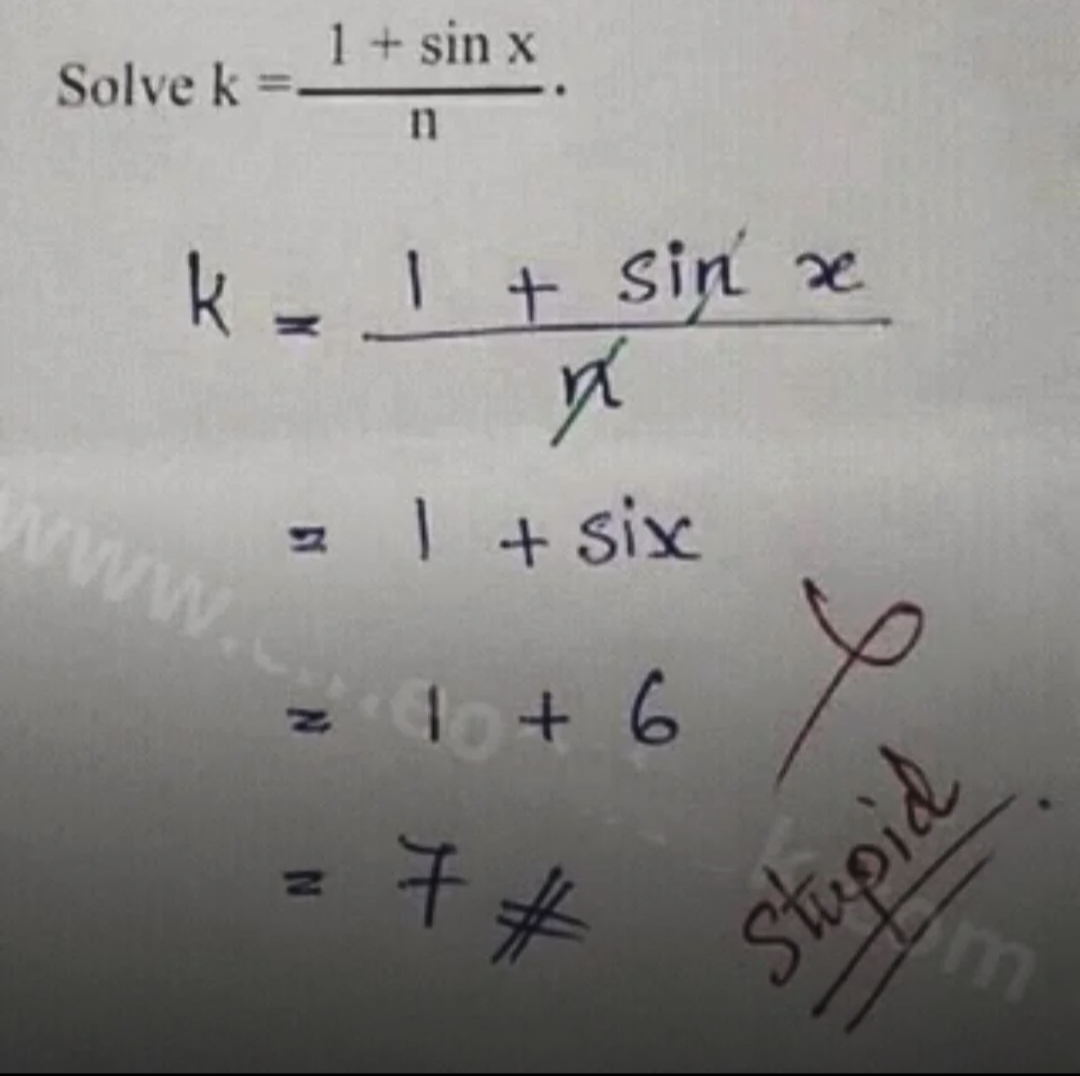There's 3 variables and 1 equation. This is unsolvable.
Funny: Home of the Haha
Welcome to /c/funny, a place for all your humorous and amusing content.
Looking for mods! Send an application to Stamets!
Our Rules:
-
Keep it civil. We're all people here. Be respectful to one another.
-
No sexism, racism, homophobia, transphobia or any other flavor of bigotry. I should not need to explain this one.
-
Try not to repost anything posted within the past month. Beyond that, go for it. Not everyone is on every site all the time.
Other Communities:
-
/c/[email protected] - Star Trek chat, memes and shitposts
-
/c/[email protected] - General memes
Since we're just making shit up anyway
Assume k=0 and n is the last natural number. Solved.
It's called a literal equation. The problem doesn't state which variable to solve for, but the assumption here is that it is x. Solving literal equations is a basic part of mathematics courses.
I'm a mathematician and I can't recall a time I've ever heard the term "literal equation." When I was in grade school the instructions were always "solve for x" if x was the variable being solved for.
Maybe it's not universal but in school literal equation basically meant there were letters instead of numbers.
It's the term we use for instance when going from the equation of a line like y=3x+2 to lines in general y=ax+b (a and b in ℝ)
And i agree it's a lot better to specify to solve for x (because you can solve for anything or have multiple variables).
Although x being a variable, and solving for it would be the most logical assumption.
I teach secondary and postsecondary math courses. The term "literal equation" was used in Texas where I taught for 17 years. The Algebra 1 state standard A.12E says that students are expected to "solve mathematic and scientific formulas, and other literal equations, for a specified variable." I also taught college undergrad courses in Texas, including College Algebra, and I don't recall ever seeing the the term used there, but I used it in class because my students were familiar with it. Now I teach in Oregon, and the term is not a part of this state's standards from what I can tell.
Grading your own work is stupid.
Would only work if the numerator was 𝑛 + sin 𝑥
That's for AP. Elementary logic let's you divide willy nilly
I cannot actually believe that back in the day, I understood what these were.
so you don't understand sin anymore? or division?
I don't sin anymore.
You should sin more, 'cos you'll go to hell and there you can get a tan
I haven't had to do anything with sin, cos or tan in over 20 years and even back then it's a miracle I managed to pass my advanced math course considering I never understood what they were because it was so badly explained to us...
Cos and Sin just return the X or Y values respectively around a circle of radius 1. So if my line starts at 0 degrees, X=1 Cos(0)=1 Sin(0)=0. I'll leave it to the reader to try 90 degrees.
...
Lulz, words
sin(x) and cos(x) return the side lengths of a triangle with hypotenuse 1 and angle x, like so:

I also was never taught this, which sucks because it's such a useful concept.
You can verify that if the angle (x) was 0, cos(x) would be 1, and sin(x) would be 0. If the angle was 90 degrees (vertical), then cos(x) would be 0 and sin(x) would be 1. If the angle was 45 degrees, cos(x) and sin(x) would have the same value, because the triangle sides would have the same length.
But why?
See, I was taught this, but no one could every answer why sine and cosine worked the way they did.
This definition just explains how they work with triangles. What's the actual definition of each, and how was that derived? I can apply them all day long yet I still can't tell you what either one means.
I had the same issues with different kinds of equations, no one ever explained why you'd do a certain thing in a given step (e.g. Quadratic) even when I asked, repeatedly. The answer was always "you just do". Well that doesn't help with knowing when to apply a rule.
And that was my experience with any math, right through college (3 universities). Most teachers suck, but holy shit math teachers are down right moronic. They can't understand why students don't get it. Well, try actually teaching something for a fucking change.
Look up a diagram of a cosine and sine functions as they relate to a rotating circle.
E.g.: https://upload.wikimedia.org/wikipedia/commons/3/3b/Circle_cos_sin.gif

How fake do you want it?
Yes
There's a teacher with no sense of humour
There's no teacher. Everything on that paper was most likely written by a single person.
All the "s"s do look very similar.
Source: I am the world's foremost forensic handwriting expert
The ink does have a different color
How do you know
I don't, it's just speculation, hence "most likely". I see similar handwriting and not a very plausible problem.
WTF bro, There is 3 variables.
Wait? NVM Wait?
Today I did Calculus for 6 hour straight. So, don't mind me I am just tired.
x = arcsin (kn - 1)
I've solved it. There you go. I hope you use this solution for something good.
It was already solved. For k.
K, but unless information isn’t shown regarding n this is unsolvable.
Solve for 1:
1 = kn - sin x
Facebook outrage post
In regards to x, x=arcsin(kn+1), where kn is between -2 and 0
